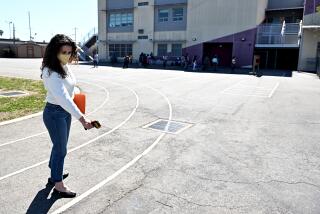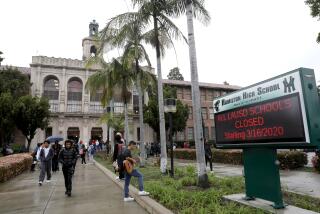A Tough Lesson in Economics
HUNTINGTON BEACH — Claremont High School is a minimalist private school. There’s no cafeteria, no field for its sports teams to practice on. Mismatched second-hand furniture fills its classrooms.
The annual $8,000 tuition isn’t invested into glamorizing the 22-year-old school, centered in an industrial park, Instead, parents and administrators said, it pays for small class sizes of about 12 pupils per teacher and a solid college prep program.
Virtually every Claremont senior goes on to college. Some enter prestigious schools such as UC Berkeley, and others continue to a local community college. Some of the students are gifted; others struggle with learning problems. All get a heavy dose of individual attention, parents say.
No one worries about the lack of luxuries; instead, these days, they worry about survival. The school’s lease is up and it has two options: either to produce $350,000 in the next four months toward the purchase of the building or move out.
“I’m not going to give up,” said school director and founder Donna Connelly. “The school’s my life and I love my work too much.”
She has not found another location, which could be even more costly, anyway, Connelly said. Although it has taken her two years to raise a third of that $350,000, Connelly said she’s confident the remaining funds will be collected by September by appealing to alumni and holding a party, among other things.
Volatility is nothing new to the school for seventh- to 12th-graders, she added.
Since it opened in 1975 at an Anaheim church, the nonsectarian school has grown from five students to this year’s record of 168, Connelly said. Because of its enrollment growth, the school has relocated five times.
In 1992, Connelly finally set out to find a permanent home for the school. She opted for the pale lemon-colored industrial building because of its potential to expand to accommodate up to 450 students.
But the undertaking has been set back by two major blows: the recession and the $600,000 in renovations it took to meet Huntington Beach city building regulations for schools. Enrollment never came close to the kind of growth Connelly foresaw, and at times Connelly has used her own home as collateral to raise money.
Even if the school could stay at this facility, much work lies ahead.
Some of the classroom floors have no tiles. The gymnasium ceiling is not yet insulated. And a lunch truck supplies students their afternoon meals.
The academic program is not short of excellence, though, parents said. The science labs are well-equipped. Small classes of five students per teacher work closely to prepare for advanced placement and other national standardized exams. And the academic emphasis annually draws 25% international students from Korea, Japan and Taiwan, to name a few countries.
“They really put their resources into the academic programs for the kids, not into looking pretty,” said Stephanie Cardin, whose three children attend Claremont.
Other parents agree that the attraction is Claremont’s small student-teacher ratios and cozy learning environment. Some students transferred to the school because they have learning disabilities and need individual attention. Others are so academically advanced that their parents said Claremont’s more rigorous curriculum was the attraction.
Cardin’s children fit perfectly within that spectrum. Her 12-year-old son skipped a grade and began Claremont this year as a seventh-grader. Her oldest son was struggling with Ds and Fs in junior high school before attending Claremont. The high school junior earned a 3.4 grade average this past semester.
“I wasn’t doing well in public schools because they were so crowded,” said Cardin’s oldest son, Michael Derichsweiler, 16. “Kids could mess around and no one would notice. But here, you’re not lost in the crowd. . . . This is where I want to graduate next year.”
Said fellow student Jarret Reid, 16: “I never liked school until I came here.”
Since fourth grade, the sophomore has shuffled among eight schools because his family moved various times for job reasons. During his first year at Claremont this year, he was able to quickly adapt to the school because of the small environment, said his grandmother, Carol Rosenstiel, with whom he now lives.
“He had a really good year,” Rosenstiel said. “He’s doing so well there that it’ll be hard without Claremont. He’s gone through so much. I hope he doesn’t have to go through change again.”
More to Read
Sign up for Essential California
The most important California stories and recommendations in your inbox every morning.
You may occasionally receive promotional content from the Los Angeles Times.










